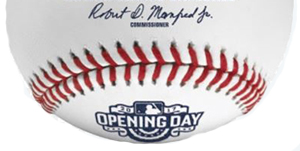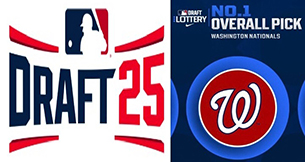
The Washington Nationals are returning their middle infield of shortstop CJ Abrams and second baseman Luis García Jr., and have replaced their corner infielders. Per manager Dave Martinez‘s request at the Winter Meetings, he was hoping that general manager Mike Rizzo would get him a new corner infield. In December, Rizzo traded to acquire first baseman Nathaniel Lowe, and patience paid off as Rizzo signed free agent third baseman Paul DeJong in February.
While Martinez didn’t qualify any of the players by name, he did say, “We’re definitely looking for some power bats at both corner spots, maybe a DH spot. We’ll see what transpires.” In addition to Lowe and DeJong, the Nats also got Martinez a new DH with Josh Bell. Combined, that trio hit 59 home runs in 2024. Last year, the Nats got 62 homers from those three positions — on the surface that looks like a drop in home runs, but these players averaged 141 games in 2024. That means substitutes at the same averages would get at-bats for an additional 63-games, and you would hope can hit another four home runs at least to beat last year’s number. Most likely they will do that by a wide margin.
But Martinez also needed new corner infielders who play excellent defense. His new third baseman, DeJong, was exceptional in his defense at third base with the Royals in August and September with an OAA of +6.0. That is Gold Glove territory numbers if you extrapolated for a full season. And Lowe is an actual Gold Glove winner as he won the award two seasons ago.
“We should be able to catch the ball, and I’m looking forward to our pitchers getting on the mound and watching those guys work.”
— Martinez said about his upgraded defense
That is it. The Washington Nationals ranked 9th in all of baseball last year in fielding-independent-pitching (FIP) at 3.94. If the fielding was just league average, the Nats pitching should have had an ERA at 3.94. By FanGraphs standards, they calculate pitcher WAR (Wins Above Replacement player value) based on the FIP modeling during the season. That shows how good/bad a pitcher would be based on his defense.
The Nats entire pitching staff for 2024 ranked 6th in the final WAR at a combined +17.4. You might think that FanGraphs would be much higher than that +17.4 for their offseason WAR calculations for the 2025 Nats’ pitching staff — but they are not close. They are currently projecting most pitchers to be below their 2024 WAR, and they have the staff at +9.6 today. Patrick Corbin is off the roster after he headed to free agency, and that alone should have improved the numbers — but yet, FanGraphs has actually lowered their projection by 45 percent at the same time as the Nats have dramatically improved their defense at both corner infield and both corner outfield positions.

With my background as a financial analyst and as a former auditor/retired CPA, this makes little sense to me about the drop in starting pitcher’s WAR based on the upgraded defense and changes in personnel. You subtract Corbin, your worst ERA pitcher, and you replace him essentially with Michael Soroka at a projected 4.45 ERA per FanGraphs along with the better defense — and the numbers should have improved. ERA should improve in 2025. The starting pitchers went from 13.1 WAR last year to a projection of 9.1 this year — for a drop of 4-wins.
Here is a chart on the starting pitcher’s WAR that we compiled from FanGraphs data:

Now if you are trying to project wins along with the standings, you need to go with reality, and the reality in 2024 was that the Nationals actually pitched to that 4.30 ERA which was the 8th worst in baseball. That is what happens when you have the 5th worst defense. The Nats were tied for the 7th worst in allowing runs to score, and a big part of that were the defensive errors that allowed 79 unearned runs to score which was the 3rd worst in baseball only ahead of the Marlins and Red Sox. The Nats .488 unearned runs allowed per game is basically a HALF RUN PER GAME just handed to the opposing teams. In a week, that is over 3.0 free runs just given to the opponents, not to mention the extra stress on the pitchers. Sure, errors are part of the game — but that is a ridiculous number. So yes, the pitching staff could be much better if the defense was better. Run prevention should have been closer to the FIP number.
The one valid debate is that you could make a case for the Nats bullpen being worse than last year. Without knowing if the Nats will have a shutdown closer, wins could hinge on the success of the bullpen in taking over with a lead and securing the lead in the late innings.
As you can see, Rizzo signed two corner infielders who should be vying for the Gold Glove awards along with outfielders, Jacob Young and Dylan Crews. With Luis Garcia Jr’s improved defense at 2nd base — the only weakness would be shortstop and the fielding by the pitchers and catchers. Abrams went through internal improvement on his own defense in the offseason as we wrote about through his work with fielding guru Nate Trosky.

For all of the chirping about the bad defense, the Nats had the best defender by OAA during the regular season in 2024 with Young in center field. He was snubbed and did not win the Gold Glove, but he showed what was possible. Crews made his debut in late August, and he showed why he won a Minor League Gold Glove this year as one of the three outfielders in the entirety of the minors to win the award. If James Wood can improve in left field, this could be the best defensive outfield in baseball in 2025.
We have been here before in an offseason with harsh discussions on the Nationals poor defense. After the 2022 season, Rizzo promised season ticket holders that the defense would be better for the 2023 season — and it was — but then it suffered in the 2024 season.
“We’re going to be a young, energetic group of guys. Defensively we’re going to be better — I promise you which makes our pitching staff better — I promise you. … That’s my promise to you guys.”
— — Rizzo’s promise after the 2022 season could be said again now
To Rizzo’s credit, this is probably the best defense he has ever put together, and of course the proof will be when we actually see it in real games. If Abrams can just improve from his 2023 defense, the Nats should almost certainly be a Top-5 defense.
For some reason, Abrams’ defense regressed last season to the worst in baseball. He put in the work over the offseason to improve, and that was a great sign that Abrams made this a priority.
“The focus of our camp is improved defense. We’ve seen early signs of an improved defense which is vital for us because we weren’t very good last year.”
— Rizzo said today on MLB Network Radio
We spoke last week to how the 2024 Kansas City Royals were built, and they reached the postseason, and made it to the division round with a Top-3 defensive team in what we call their new Moneyball approach.
With the Nats’ analytics department have been following the 2024 Royals, the 2023 Diamondbacks, or just baseball commonsense — they had to improve — and they did.
“[Lowe] catches the ball. He makes all the plays. It’s a good target for our infielders to throw over there as well. It makes things a lot easier.”
— Martinez said about Lowe and DeJong
“[DeJong’s] play at third base, his metrics numbers are real good over there defensively.”
While we don’t know if the Nationals will excel in all facets of the game, an improved defense should help the pitching. A goal of beating that FIP number as a real ERA of 3.94 should be the goal. Last year, the Top-10 FIP teams won at least 80 games except the Nationals. and all but the Giants, Mariners, and Nats didn’t make the postseason from that Top-10 FIP. And the Top-10 ERA teams all won at least 80-games in 2024.
This goes back to the theory that it all starts with pitching. And the smart analytics teams are building better pitching staffs through good pitchers supported by great defense. That is how you win without one of those $200 million ace pitchers, and exactly how the Royals did it last year.
In 2024, the Nationals analytically fine-tuned Trevor Williams to pitch two times through the opposing batting order and he pitched to a 2.03 ERA. If the Nats can replicate Williams’ success through pitching analytics along with the better defense, this could be the secret sauce.









